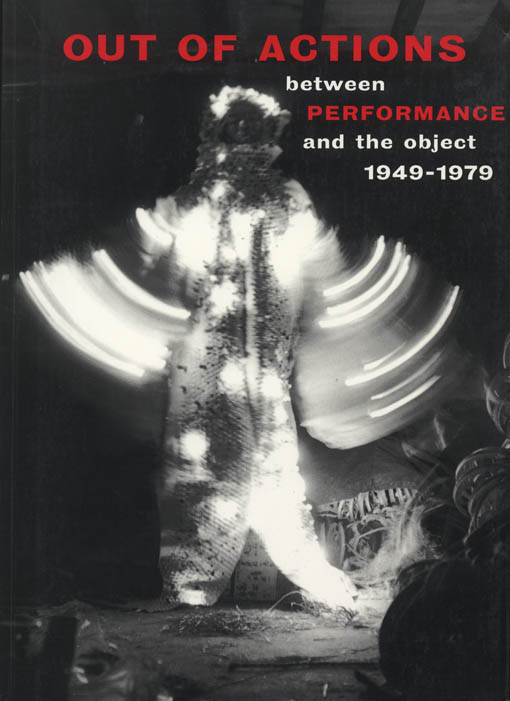Out of Actions: Between Performance and the Object, 1949-1979 (1998)
Filed under book, catalogue | Tags: · 1950s, 1960s, 1970s, art, art criticism, art history, painting, performance, performance art, sculpture

“The rise of performance art, and its merging with more traditional forms like painting and sculpture, is the great revolution of post-war art. Its links to theater, photography, music, dance, politics, and popular culture have made it especially appealing to contemporary artists in remote areas; more than any other movement in recent art, performance has found a place throughout the world.
Covering three decades of significant and original art, this book features work by more than one hundred artists from the United States, South America, Eastern and Western Europe, and Japan who have had a profound impact on the relationship between visual and performance art in the postwar era. Among the artists included are Joseph Beuys, Chris Burden, John Cage, Lygia Clark, Yves Klein, Marta Minujin, Bruce Nauman, Helio Oiticica, Claes Oldenburg, Yoko Ono, Robert Rauschenberg, Niki de Saint Phalle, Atsuko Tanaka, and Jean Tinguely. Their work encompasses performative objects such as sculpture, artists’ publications, drawings, photographs, and ephemera that come from performances, as well as documentary film and video stills.
Published in conjunction with a major exhibition, organized by The Museum of Contemporary Art, Los Angeles, curated by Paul Schimmel (08.02.1998–10.05.1998), Out of Actions illuminates the unique relationship between action, destruction, performance, and the creative process. Covering an unprecedented range of material, both nationally and temporally, the book offers the first critical comparisons.”
Edited by Paul Schimmel, Russel Ferguson, Kristine Stiles
Publisher Thames and Hudson, 1998
ISBN 9780500280508
407 pages
Review: Beáta Hock (Artpool, n.d.).
PDF (104 MB, no OCR; updated on 2017-7-10)
Comments (3)Brian Massumi: Semblance and Event: Activist Philosophy and the Occurrent Arts (2011)
Filed under book | Tags: · abstract art, aesthetics, art, event, interactive art, kinesthesia, movement, perception, performance art, philosophy, politics, proprioception, semblance, time, vision

Events are always passing; to experience an event is to experience the passing. But how do we perceive an experience that encompasses the just-was and the is-about-to-be as much as what is actually present? In Semblance and Event, Brian Massumi, drawing on the work of William James, Alfred North Whitehead, Gilles Deleuze, and others, develops the concept of “semblance” as a way to approach this question.
It is, he argues, a question of abstraction, not as the opposite of the concrete but as a dimension of it: “lived abstraction.” A semblance is a lived abstraction. Massumi uses the category of the semblance to investigate practices of art that are relational and event-oriented–variously known as interactive art, ephemeral art, performance art, art intervention–which he refers to collectively as the “occurrent arts.” Massumi argues that traditional art practices, including perspective painting, conventionally considered to be object-oriented freeze frames, also organize events of perception, and must be considered occurrent arts in their own way. Each art practice invents its own kinds of relational events of lived abstraction, to produce a signature species of semblance.
The artwork’s relational engagement, Massumi continues, gives it a political valence just as necessary and immediate as the aesthetic dimension. Massumi investigates occurrent art practices in order to examine, on the broadest level, how the aesthetic and the political are always intertwined in any creative activity.
Publisher MIT Press, 2011
Technologies of Lived Abstraction series
ISBN 0262134918, 9780262134910
220 pages
PDF (updated on 2012-7-24)
Comment (0)IDEA Arts + Society (2003–) [Romanian/English]
Filed under magazine | Tags: · activism, art, art criticism, art theory, autonomy, capitalism, contemporary art, cultural criticism, eastern europe, institutional critique, performance art, politics, romania, society, southeastern europe, theory, video art

Idea 36-37, 2010

Idea 35, 2010
“IDEA art+society is a multiannual publication produced by IDEA, Cluj. It is published under its current form since 2003.
Allegiance to the exigency of genuine theory – a theory which is, first of all, its own practice – this is the program of IDEA arts+society magazine. This means: the practice of the concerned eye, which can be rigorous solely through the unconditional solidarity with the concrete. It is a practice of thinking which is alien to any aestheticism, hostile to any institutionalized transcendence, immune to the biased fiction of ideological neutrality, and remote from the pernicious language of our contemporary culture of ‘experts.’ In brief, it is the practice of critical and defiant reflection, dramatically lacking in the intellectual-civic debates of present-day Romania.
The graphical and logical operator ‘+’ functions as the material figura of all these dimensions, to which we can add artistic education and the public influence of art. The various ways of deciphering this sign suggest the manifold articulations between the artistic and the social realm. That is, the political.”
IDEA artă + societate / IDEA arts + society
Editors: Bogdan Ghiu, Ciprian Mureșan, Timotei Nădășan (editor-in-chief), Alexandru Polgár, Adrian T. Sîrbu, Ovidiu Țichindeleanu, Raluca Voinea
ISSN 1583–8293

